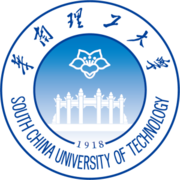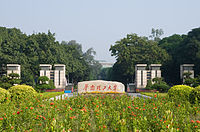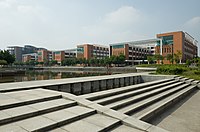South China University of Technology
华南理工大学 | |
 | |
Former names | South China Institute of Technology[1] |
|---|---|
| Motto | 博学慎思 明辨笃行 |
Motto in English | Study Extensively, Enquire Accurately; Discriminate Clearly, Practise Earnestly |
| Type | Public coeducational |
| Established | 1952 |
| President | Gao Song (2018/10-) |
Academic staff | 2,917 (2018)[2] |
| Undergraduates | 24,861 (full-time, 2018)[2] |
| Postgraduates | 17,144 (2018)[2] |
| 3,352 (2018)[2] | |
Other students | International students: 1,829 (2018)[2] |
| Address | Wushan Campus (North Campus): , , , 381 Wushan Rd, Tianhe District University Town Campus (South Campus): 382 Waihuan Dong Rd, HEMC, Panyu District Guangzhou International Campus (GZIC): 777 Xingye Dadao Xi, Panyu District |
| Campus | Multiple Sites |
| Affiliations | Project 985, Project 211, The Excellence Union |
| Website | www www |
South China University of Technology (SCUT; simplified Chinese: 华南理工大学; traditional Chinese: 華南理工大學; pinyin: Huánán Lǐgōng Dàxué, orally known as Huágōng 华工) is a major public research university in China. It is located in the Tianhe District and Panyu District of Guangzhou, capital of Guangdong Province, China. It is a multidisciplinary university focusing on engineering, combined with science, also promoting well coordinated development of management, economics, humanities and law.[1] Its engineering ranks at 22nd among world universities according to Academic Ranking of World Universities (ARWU) in 2016. U.S. News & World Report ranks South China University of Technology 46 in engineering among Best Global Universities in 2018.[3] It is a Chinese Ministry of Education Class A Double First Class University.[4]
History


- Formerly known as the South China Institute of Technology (华南工学院), it was established in 1952, through a reorganization process that unified the engineering schools and departments of major universities from five provinces in Central and Southern China, including the former National Sun Yat-sen University, Lingnan University, Hunan University, Guangxi University, South China Joint University, and four others.
- In 1960, it was selected as one of 33 National Key Universities, under the direct administration of the Chinese Ministry of Education.
- The University was renamed as South China University of Technology in 1988.[1]
- In 1995, it was selected as one of the universities into which China will make a significant investment in the 21st century as part of Project 211.
- In 1999, it was rated "excellent" during the Undergraduate Teaching Assessment, and was among the first "Excellent Universities of Undergraduate Education" in the country. In the same year, a national science park was established with the authorization of the State Ministry of Technology and State Ministry of Education.
- In 2000, authorization was given for the establishment of a Graduate School.
- In 2001, it became one of the 39 national universities sponsored by Project 985.
- In 2017, it became one of the 36 Class A Double First-Class Universities.
Rankings
| University rankings | |
|---|---|
| Global – Overall | |
| THE World[5] | 501-600 (2018) |
| National – Overall | |
| BCUR National[6] | 19 (2018) |
- In the 2013 Leiden Ranking of universities according to the proportion of their scientific publications that rank among the top 10% in their field, SCUT was ranked 138th in the world, 11th in Asia, and 5th in China (excluding Hong Kong) behind Nankai University, Hunan University, University of Science and Technology of China, and Lanzhou University.[7]
- The same year's QS University Rankings placed the university at 151-160th in Asia.[8]
- The 2014 Best Global Universities Rankings (usnews) ranked South China University of Technology 400-450th, with its engineering placed at 68th.[9]
- The university ranked 300-400th among world universities according to the 2014 ARWU. Its engineering was among the top 50 according to the same ranking.[10]
- The university ranked 300-400th according to the 2015 Academic Ranking of World Universities (ARWU). In particular, its engineering was ranked 48th, and chemistry 101-150th among world universities.[3]
- The university ranked 349th according to the 2017 U.S. News & World Report Best Global Universities.[11]
- The university ranked 361th according to the 2019 U.S. News & World Report Best Global Universities.[12]
Campuses and Schools
There are three SCUT campuses, both located in Guangzhou: Wushan Campus (or North Campus), University Town Campus (or South Campus, HEMC Campus) and Guangzhou International Campus (GZIC). The headquarters of the university are on the Wushan Campus.
Of SCUT's 32 schools, 17 are located on the Wushan Campus, 11 on the University Town Campus, and 4 on the GZIC.
Wushan Campus (North Campus)



This campus was formerly part of the National Sun Yat-sen University campus, and many buildings remain from that time.
17 schools:
- School of Architecture
- School of Automation Science & Engineering
- School of Business Administration
- School of Chemistry and Chemical Engineering
- School of Civil and Transportation Engineering
- School of Electric Power
- School of Electronic and Information Engineering
- School of Food Science and Engineering
- School of Foreign Languages
- School of Light Industry and Engineering
- School of Materials Science and Engineering
- School of Mathematics
- School of Marxism
- School of Mechanical & Automotive Engineering
- School of Physical Education
- School of Physics and Optoelectronic Technology
- School of Public Administration
University Town Campus (South Campus)

11 schools:
- School of International Education
- School of Arts
- School of Bioscience and Bioengineering
- School of Computer Science & Engineering
- School of Design
- School of Economics and Commerce
- School of Environment and Energy
- School of Journalism and Communication
- School of Law
- School of Software Engineering
- School of Medicine
Guangzhou International Campus (GZIC)

4 schools:
- School of Micro-electronics
- School of Molecular Science and Engineering
- Shien-Ming Wu School of Intelligent Engineering
- School of Biomedical Sciences and Engineering
Alumni
Politicians and military
- Cheng Siwei – Vice Chairman of The National People's Congress
- Wan Qingliang – Former mayor and CCP secretary of Guangzhou City
- Lin Shusen – Former Governor and Deputy Communist Party Chief of Guizhou Province
Athletes
- Chen Ding – 2012 Summer Olympics gold medallist in the 20 kilometres walk
Academics
- He Jingtang – Dean of School of Architecture of SCUT, Member of China Academy of Engineering and the main designer of the acclaimed China Pavilion at the 2010 Shanghai World Expo.[13]
- Thomas Hou – Charles Lee Powell Professor of Applied and Computational Mathematics at the California Institute of Technology
- Rong Baisheng, architect and civil engineer
Businesspeople
- Li Dongsheng – CEO of TCL Corporation
- Zhang Zhidong – Former CTO of Tencent
- He Xiaopeng – Co-founder and president of UCWeb Inc.
References
- ^ a b c "Introduction".
- ^ a b c d e "华南理工大学2017-2018学年本科教学质量报告" [Undergraduate Teaching Quality Report of 2017-2018, South China University of Technology] (in Chinese (China)). SCUT Information Disclosure Website. 2019-01-01. Retrieved 2019-08-04.
- ^ a b http://www.shanghairanking.com/FieldENG2015.html
- ^ "教育部 财政部 国家发展改革委 关于公布世界一流大学和一流学科建设高校及建设 学科名单的通知 (Notice from the Ministry of Education and other national governmental departments announcing the list of double first class universities and disciplines)".
- ^ THE World University Ranking - 2018
- ^ Best Chinese Universities Ranking, Overall Ranking - 2018
- ^ "CWTS Leiden Ranking 2013". Centre for Science and Technology Studies (CWTS) and Leiden University. Retrieved 19 March 2014. For details on the survey's methodology, see "CWTS Leiden Ranking 2013". "Data collection".
- ^ "South China University of Technology Rankings", QS Asian University Rankings, 2013
- ^ https://www.usnews.com/education/best-global-universities/south-china-university-of-technology-505115
- ^ http://www.shanghairanking.com/FieldENG2014.html
- ^ http://arcst.whu.edu.cn/ranking/17666.jhtml
- ^ https://www.sohu.com/a/272255019_407295
- ^ "Professor He Jingtang".
